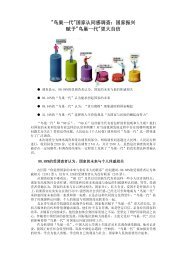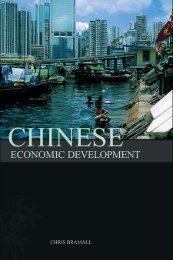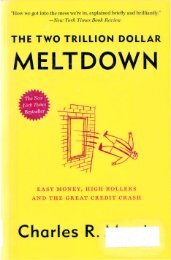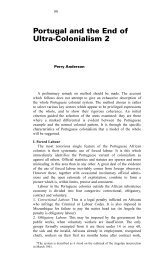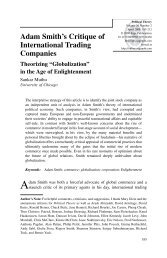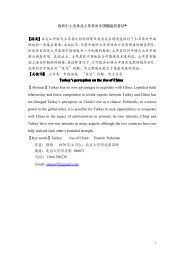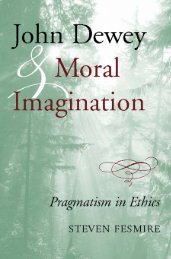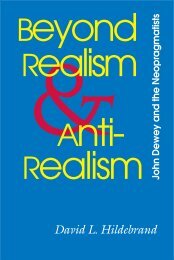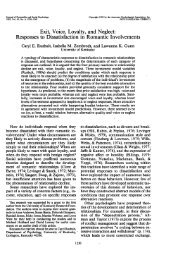Battle for China's Past : Mao and the Cultural Revolution
Battle for China's Past : Mao and the Cultural Revolution
Battle for China's Past : Mao and the Cultural Revolution
You also want an ePaper? Increase the reach of your titles
YUMPU automatically turns print PDFs into web optimized ePapers that Google loves.
THE BATTLE FOR CHINA’ S PAST<br />
Chapter 3 is an analytical review of memoirs, autobiographies <strong>and</strong><br />
biographies on <strong>the</strong> <strong>Mao</strong> era published in Chinese language. The literature<br />
is vast <strong>and</strong> this is <strong>the</strong> first study that seeks to treat it as a whole.<br />
The chapter first draws a sketch of <strong>the</strong> literature. It <strong>the</strong>n analyses<br />
several <strong>the</strong>mes in light of traditional Chinese historiography <strong>and</strong><br />
shows that <strong>the</strong> literature focuses on personal struggles <strong>and</strong> court<br />
intrigues, while ignoring contentious political <strong>and</strong> socioeconomic<br />
issues in society at that time. The resulting ‘history’ justifies those<br />
writers’ present views <strong>and</strong> opinions but neglects many inconvenient<br />
historical facts. In this history, remembered personalities are often<br />
portrayed in a Peking opera style, analogous to pure good confronting<br />
evil incarnate, <strong>and</strong> many legitimate memories which might have a<br />
different voice <strong>and</strong> different views are silenced.<br />
Chapter 4 focuses on a critique of Jung Chang <strong>and</strong> Jon Halliday’s<br />
book <strong>Mao</strong>: The Unknown Story. It first summarizes how <strong>the</strong>ir book is<br />
promoted by hype in <strong>the</strong> media. It <strong>the</strong>n examines <strong>the</strong> book in detail<br />
<strong>and</strong> reveals how it misinterprets evidence, ignores <strong>the</strong> existing literature,<br />
<strong>and</strong> makes sensationalist claims without proper evidence. It is<br />
argued that it is intellectually sc<strong>and</strong>alous that <strong>the</strong> Chang <strong>and</strong> Halliday<br />
book has received so many positive reviews given <strong>the</strong> fact that its<br />
scholarship is obviously questionable.<br />
By presenting arguments <strong>and</strong> discussion in <strong>the</strong> e-media that are<br />
nei<strong>the</strong>r available in print <strong>and</strong> broadcast media nor accessible to those<br />
who do not read Chinese, <strong>and</strong> by in-depth analysis of claims made in<br />
<strong>the</strong> Chang <strong>and</strong> Halliday book, <strong>the</strong> chapter reveals how <strong>the</strong> co-authors<br />
have constructed a deeply misleading version of history. The chapter<br />
concludes with a discussion of why such intellectual sc<strong>and</strong>al matters to<br />
<strong>the</strong> academic community.<br />
As a counter-narrative to Chang <strong>and</strong> Halliday’s ‘constructed story’,<br />
Chapter 5 argues that <strong>the</strong>re is a known <strong>and</strong> readily available story that<br />
Chang <strong>and</strong> Halliday chose to ignore. This is <strong>the</strong> story that gives<br />
primacy to <strong>the</strong> Chinese people <strong>and</strong> to <strong>the</strong>ir part in <strong>the</strong> revolution led<br />
by <strong>the</strong> CCP under <strong>Mao</strong>’s leadership, a revolution in which Chang’s<br />
parents participated, a revolution from which Chang herself benefited.<br />
It is a story that that does not deny or <strong>for</strong>get that it was due to this revolution<br />
that <strong>the</strong> average life expectancy of <strong>the</strong> majority Chinese<br />
increased from 35 in 1949 to 63 by 1975, that it was a revolution that<br />
brought unity <strong>and</strong> stability to a nation tortured <strong>for</strong> so long by disunity<br />
<strong>and</strong> instability, <strong>and</strong> a revolution that laid <strong>the</strong> foundation <strong>for</strong> China to<br />
become <strong>the</strong> equal of <strong>the</strong> world’s great powers. It is a story about a revolution<br />
‘of <strong>the</strong> people’ that enabled l<strong>and</strong> re<strong>for</strong>m, that promoted<br />
women’s status, that improved popular literacy <strong>and</strong> healthcare, <strong>and</strong><br />
that eventually trans<strong>for</strong>med Chinese society beyond recognition from<br />
its parlous state prior to <strong>the</strong> <strong>Revolution</strong>. In this connection <strong>the</strong> chapter<br />
[ 10 ]





